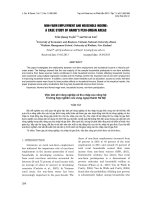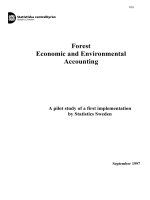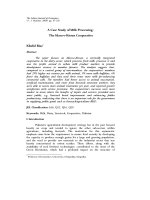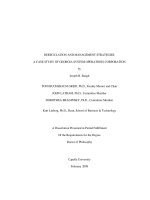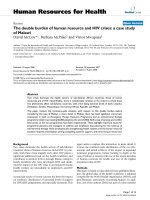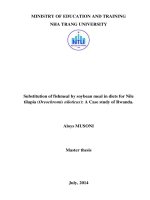Globalization, identity and heritage tourism a case study of singapores kampong glam
Bạn đang xem bản rút gọn của tài liệu. Xem và tải ngay bản đầy đủ của tài liệu tại đây (5.53 MB, 327 trang )
GLOBALISATION, IDENTITY AND HERITAGE TOURISM:
A CASE STUDY OF SINGAPORE‟S KAMPONG GLAM
DAVID TANTOW
NATIONAL UNIVERSITY OF SINGAPORE
2009
2
GLOBALISATION, IDENTITY AND HERITAGE TOURISM:
A CASE STUDY OF SINGAPORE‟S KAMPONG GLAM
DAVID TANTOW
(B. Sc. and M. Sc.)
A THESIS SUBMITTED FOR THE DEGREE OF
DOCTOR OF PHILOSOPHY
DEPARTMENT OF GEOGRAPHY
NATIONAL UNIVERSITY OF SINGAPORE
2009
3
ABSTRACT
The thesis analyses the impact of ethnic policies on heritage districts in post-colonial nations,
through a case study of Malay-Muslim minority heritage in Singapore. The dissertation explores
the link between nation building with its ―politics of heritage‖ and tourism-induced cultural
changes, and considers these two factors shaping representations of ethnic heritage in
combination; a combination that has not been sufficiently discussed in most previous tourism
studies. It shows that the Singapore government has not developed an exact definition of the
Malay contribution to the social identity of Singaporeans and multicultural nation building.
Applying a perspective from urban geography on the consequences of urban renewal on the
minority district of Kampong Glam, I argue that the role that Malay-Muslim culture should have
played in the representation of ethnic heritage after the end of urban renewal in 1989 was also
unclear. Since the government did not define a theme of representation for Kampong Glam‘s
urban environment, tourism brokers developed their own interpretation of the Malay-Muslim
legacy. They displayed a ―cosmopolitan‖ Middle Eastern representation of Muslim heritage,
largely neglecting the local Malay minority community. This glamorous and cosmopolitan
representation of heritage inaccurately portrays the local Muslim population as an Arab trading
caste, emphasising their ancient trade connections with the Middle East. In contrast, the
Singapore government‘s nation building approach continues to disregard the urban legacy of the
local Malay-Muslim community, largely ignoring their prominence as seafarers and explorers, a
fact that indicates that ―The myth of the lazy native‖ (Alatas 1977) persists in relation to the
Malay community after Singapore‘s independence. The analysis is based on one year of
ethnographic research in the Malay-Muslim heritage district, combined with an in-depth survey of
its business community with a response rate of 64%, 350 multi-lingual questionnaires of
Singaporean visitors and tourists and 25 in-depth interviews with selected local stakeholders.
4
ACKNOWLEDGEMENTS
Many great people have helped me during the past four years while I was working on this thesis. I
am grateful to all of them; they have made my time in Singapore exciting and also contributed to
make it an academically enriching experience for me. I hope that I can thank them all:
Thanks to Prof. T.C. Chang, who is indeed a great motivator. He always supported me when
things did not go too well and always gave me the freedom for my own accentuations as well as
when I was TA-ing. I will always remember our time together fondly.
The other members of my committee, Prof. K.C. Ho of Sociology and Prof. John Miksic of
Southeast Asian Studies greatly contributed to my learning process as a PhD student. Thanks,
K.C., for your help with my data analysis, and thanks, John, for your first-hand insights about the
local history and archaeology.
I also would like to thank all other faculty members who took an interest in my research and gave
me tips about relevant literature or fieldwork approaches. Special thanks to Prof. Tim Bunnell for
sharing his insights about ―Malay modernity‖ and Prof. Nathalie Oswin for going through my
theoretical framework with me.
Old friends and many family members flew halfway across the globe to visit and support me,
some of them came on several visits. Thank you, ―Mama, Papa und Nora‖ for bringing me news
from home and moral support. Thanks to Eveline, David, Stefan and Caroline for spending time
with me in Singapore and helping me to get my PhD started and thanks to Claude for computer
support.
Thanks to my new friends in Singapore. Many helped me with my surveys and interviews. Thank
you, Mike, Satchko and Yuka for helping me reach out to Asian tourists. Thanks to Brian,
Jennifer and Isdino for help with the Malay language and taking the great pictures of Kampong
Glam.
Thanks to NUS for the generous and steady financial support that enabled me to concentrate on
my research.
David Tantow, Singapore, December 2009
5
ABBREVIATIONS
ASEAN
CPG
Association of Southeast Asian Nations
Corporate Planning Group
KGBA
Kampong Glam Business Association
LTA
Land Transport Authority
MHC
Malay Heritage Centre
NUS
National University of Singapore
STB
Singapore Tourism Board (successor of the STPB)
STPB
Singapore Tourism Promotion Board (after 1997 STB)
URA
Urban Redevelopment Authority
WW I
World War I
WW II
World War II
6
TABLE OF CONTENTS
LIST OF TABLES 9
LIST OF FIGURES 10
1. Introduction 12
1.1 The Post-Colonial Crises of Identity and Heritage Tourism 16
1.2 Exploring Links between Heritage, Tourism and Post-Colonial Identity 21
1.2.1 The Commodification of Heritage for Tourism 24
1.2.2 “Politics of Heritage” 25
1.2.3 Acceptance or Contestation of Heritage 27
1.2.4 The Tourist Consumption of Heritage 28
1.3 Kampong Glam: A Timely Case Study on Representation 30
1.4 Overview of the Thesis 34
2. Literature Review and Theoretical Considerations 38
2.1 Introduction 38
2.2 Place Identity and the Representation of Ethnic Heritage 41
2.2.1 Globalisation and Heritage – The Destruction of Local Uniqueness? 41
2.2.2 Multiple Outcomes of Cultural Globalisation: The Global–Local Nexus 44
2.2.3 Heritage Landscapes, Nation-Building and Global Tourism 48
2.3 A Post-Colonial Perspective on Heritage Tourism in Multi-Ethnic States 54
2.3.1 A Brief History of Post-Colonialism 54
2.3.2 The Post-Colonial Perspective and Tourism Studies 56
2.3.3 Kampong Glam and the Post-Colonial Discourse 60
2.3.4 “Hybridisation” and the Creation of New Place Identities 63
2.3.5 Post-Colonial Nation-Building, Multiculturalism and Multiracialism 64
2.3.6 From Post-Colonial Multiracialism to Cosmopolitanism 68
2.4 Conclusion 71
3. Methodology 74
3.1 Introduction 74
3.2 Methodological Commitment and Conceptual Framework 74
3.3 Data Collection 77
3.3.1 In-depth Interviews 78
3.3.2 Questionnaire Surveys 80
3.3.3 Participant Observation 85
3.3.4 Secondary Data 87
3.4 Data Analysis 89
7
3.5 Research Ethics and Researcher Positionality 91
3.6 Conclusion 93
4. The Research Locality, Local Policy and the Reshaping of Identity 95
4.1 Introduction 95
4.2 Singapore as a ―Colonial Cosmopolis‖ 95
4.2.1 Kampong Glam – The “Hybrid” Culture of an Evolving Maritime Hub 97
4.2.2 A Redefinition of Malayness – Self-Essentialising as Village Dwellers 99
4.2.3 Kampong Glam as a Centre for Malay Nationalism 102
4.3 Post-Independence: The CMIO–Scheme and Cultural Heritage 104
4.3.1 The 1970s and Ethnic Heritage: “Race without Space” 105
4.3.2 The 1980s: Enhanced Representation of Heritage against Westernisation 106
4.3.3 Nation-Building and Spatial Practices: Heritage and the CMIO–Scheme 110
4.3.4 Ethnic Heritage in Kampong Glam – The Litmus-Test for Nation-Building? 114
4.4 Recent Developments since the 1990s: Rediscovery of Cosmopolitan Heritage 118
4.4.1 A Global City-State with Cosmopolitan Heritage – The Underlying Policy 120
4.4.2 Singapore as a Cosmopolitan “Renaissance City” 122
4.4.3 Tourism Promotion as the “Hip Hub” 123
4.4.4 A Cosmopolitan Kampong Glam – Interconnected Heritage 125
4.4.5 Cosmopolitanism and Malayness – A Mismatch? 130
4.5 Conclusion 135
5. Kampong Glam – The Evolution of Built Heritage 139
5.1 Introduction 139
5.2 Religious Tourism Hub and Trading Centre 140
5.3 The Fragmentation of Islamic Heritage 146
5.3.1 Urban Renewal and an Isolated “Survivor”: Hajjah Fatimah Mosque 148
5.3.2 Exclusion II: The Madrasah Al-Junied and the Aristocratic Graveyard 150
5.3.3 Maritime Heritage – The Bygone Function as a Maritime Hub 154
5.3.4 Pondok Jawa I – A Cultural Centre for Javanese Migrants 158
5.3.5 Pondok Jawa II – A New Approach to Heritage Presentation? 160
5.4 Technical Basics of Conservation – Legal Guidelines for Ethnic Space in Singapore 161
5.5 Sultan Mosque: A Landmark of Rare Continuity 163
5.5.1 The Preservation of the Mosque 163
5.5.2 Limitations of a Single Landmark 167
5.6 Recreated Bussorah Street: Ethnic Space Enhanced or Undermined? 167
5.6.1 Pre-Conservation Commercial Decline 167
5.6.2 The Creation of Bussorah Mall – A “Commercial Flagship” 169
8
5.6.3 Bussorah Mall – The Tangible Heritage Conserved 173
5.6.4 The Discontinuity of Social and Cultural Life at Bussorah Mall 176
5.6.5 Tackling Adaptive Re-Use Problems with a Revised Role of the URA 179
5.7 The Istana Kampong Glam – Re-Establishing Ethnic Culture 182
5.7.1 The Heritage Centre Planning Process 182
5.7.2 The Soft Opening of the Malay Heritage Centre (MHC) 188
5.7.3 A Lack of Community Involvement Today – The Underlying Reasons 190
5.8 Conclusion 195
6. Malay and Muslim Culture and Heritage Conservation – Reactions to the Re-
Engineering of Ethnic Space 198
6.1 Introduction 198
6.2 Commercial Revitalisation – A Buzzing District of Global Tourism? 199
6.2.1 Basic Facts about Commercial Revitalisation at Kampong Glam 199
6.2.2 The Commercial Flagship – Bussorah Mall and Tourist Satisfaction 203
6.2.3 Local Reactions to Bussorah Mall 206
6.2.4 The Flagship Role: Generating Revitalisation as Intended? 209
6.2.5 The Limitations of Spillover Effects from Bussorah Mall 213
6.3 A Cultural Flagship to Complement Bussorah Mall – The MHC 216
6.3.1 Likely to Disappoint? – A Flagship Project to Meet All Expectations 216
6.3.2 The MHC and the Cultural Flagship Role: A Lack of Spillover 218
6.3.3 “Reaching the Young” – Mission Unaccomplished 222
6.3.4 The MHC – The Latest Ethnic Attraction in a String of Failures? 226
6.3.5 Tourist Attraction and Community Centre – A Tricky Dual Role 230
6.4 Preservation as Rhetoric? Voices from the District‘s Periphery 233
6.4.1 The Social Value of Heritage Preserved? Two Areas Compared 233
6.4.2 Jalan Kecil and the Contestation of Government Plans 237
6.4.3 Tapping a New Resource – A Commercial Alliance for Cultural Heritage 242
6.4.4 Haji Lane‟s Enthusiasm – “Malay” Initiatives from an Unlikely Venue 246
6.4.5 A Venue for Cosmopolitan Malay Culture? – Opportunities and Limits 251
6.5 Conclusion 255
7. Conclusion 260
7.1 Synthesis of Findings 260
7.2 Research Findings and Implications for Policy 268
7.3 Contributions to the Post-Colonial Discourse on Heritage 271
REFERENCES 281
APPENDIX 317
9
LIST OF TABLES
Tab. 3.1: Research Strategies – data required and methods used 76
Tab. 3.2: Interview partners and thematic focus of interviews 79
Tab. 3.3: Overview of secondary data sources and research themes 89
Tab. 4.1: Muslim population in Kampong Glam in the early 20th century 98
Tab. 4.2: Contrasting attributes of Kampong Glam and Kampung Melayu 101
Tab. 4.3: The essentialist perspective of the CMIO scheme and local heritage 112
Tab. 4.4: Changing share of locally born and resident population over time 121
Tab. 4.5: Textual analysis of Kampong Glam‘s heritage - as portrayed in guidebooks 133
Tab. 5.1: Declining frequentation of the heritage centre 188
Tab. 6.1: Revitalization – voices from Kampong Glam‘s periphery 238
10
LIST OF FIGURES
Figure 1.1: Sultan Mosque surrounded by Shophouses at Kampong Glam 15
Figure 4.1: Ethnic Heritage in the Midst of the Urban Renewal High-Rise Landscape 109
Figure 4.2: Malay-Muslim Heritage in Decay in 2007 115
Figure 4.3: The Entrance of the Malay Village in Geylang Serai 115
Figure 4.4: A Village behind Palace Walls – Kampong House within the MHC in 2006 117
Figure 4.5: Tourism Promotion with ―Exciting‖ Activities in Singapore 124
Figure 4.6: Advertising for Kampong Glam from the Public Affairs Directorate 128
Figure 4.7: Seafaring – Malay Transnational Connections Highlighted 134
Figure 5.1: Medical Examination Centre for Pilgrims in Kampong Glam in 1965 142
Figure 5.2: Jeddah Street Leading to Masjid Bahru 143
Figure 5.3: Arab Mosaic Tiles at Bussorah Mall 144
Figure 5.4: Map of Kampong Glam‘s Sub-Zones and Heritage Attractions 147
Figure 5.5: Hajjah Fatimah Mosque after Urban Renewal 149
Figure 5.6: The Royal Graveyards North of the Kampong Glam Conservation Zone 151
Figure 5.7: The Madrasah Al-Junied and Family Tombs in the 1990s (left) and today 152
Figure 5.8: Land Reclamation and Beach Road in the 1980s and 1950s 155
Figure 5.9: Maritime Heritage on Display at the MHC 157
Figure 5.10: The Mosque as a Draw for Locals 166
Figure 5.11: Bussorah Street from 1980s to the Present 169
Figure 5.12: Private Ownership at Various Streets of Kampong Glam 172
Figure 5.13: Public Evaluation of the State of Tangible Heritage 174
Figure 5.14: From ―Istana Kampong Glam‖ to ―Malay Heritage Centre‖ 185
Figure 5.15: Reactions to the Istana as Location for the MHC 186
Figure 5.16: Visitation of the MHC 189
Figure 6.1: Local Shopowners and their Evaluation of Conservation Efforts 202
11
Figure 6.2: Tourist Evaluation of Bussorah Mall at Kampong Glam 205
Figure 6.3: Local and Tourist Perception of Bussorah Mall: A Comparison 207
Figure 6.4: Evaluation of Revitalisation Efforts by Shopowners – A Vital Business Mix? 211
Figure 6.5: Malay and Muslim Frequentation Based on the Share of Customers 213
Figure 6.6: Turn from the Main Street (right) to the MHC without Signposting 220
Figure 6.7: The Cultural Landmark – Revitalisation Caused by the MHC Opening? 221
Figure 6.8: The Centre is Well-Restored (Tan 2005) but has Weak Community Integration 222
Figure 6.9: Evaluation of the MHC‘s Attractiveness – A Local Perspective 224
Figure 6.10: Representation of Ethnic Culture in the MHC – A Lack of Variety 225
Figure 6.11: Tang Dynasty Village in Decay in 2007, a ―Failed Dream for Culture‖? 227
Figure 6.12: Kampong Glam Sub-Zones as Identified by the Business Survey 235
Figure 6.13: Record of Malay Ownership at Jalan Kecil 240
Figure 6.14: Reasons for Locating Commercial Outlets in Present Location 245
Figure 6.15: Muslim Street Life on Haji Lane – A Family Resting in Front of their Shop 247
Figure 6.16: Malays Gathering in the Five-foot Walkway 249
Figure 6.17: Malay Student Shopping at Haji Lane Boutique 250
Figure 6.18: Malay Rock and Pop Music LP-Covers for the Connoisseur 253
Figure 7.1: North Bridge Road – No Design Elements or Pedestrian Crossing 269
12
Chapter 1
1. Introduction
Singapore tourism has undergone spectacular growth since independence in 1965. In 1964, visitor
numbers only amounted to 91,000 arrivals (STB 1995) because of race riots and political unrest.
In 2007, the Singapore Tourism Board (STB) published a new all-time record – 10.3 million
tourists travelled to the city-state (STB 2008). Singapore‘s tourism development is a quantitative
success story and the steady growth is outstanding even within a booming region (Khan 1998);
comparatively, the arrivals into Indonesia, Singapore‘s largest ASEAN neighbour, have stagnated
at around five million for the past 10 years (Cochrane 2009).
Although positive economic conditions in Asia helped, a key factor for growth is the
diversification of tourist attractions over the decades (Chang 1997). An important step for
diversification was to identify urban historic areas as heritage assets in the 1980s (Mullins 1999,
Yeoh et al. 2001). In 1989, local planning agencies, the Urban Redevelopment Authority (URA)
and the Singapore Tourism Board (STB), officially declared selected inner-city quarters of the
three major ethnic groups (Chinese, Malay and Indian) as conservation districts to showcase
Singapore‘s multi-cultural heritage to local visitors and foreign tourists. The heritage of ―Ethnic
Singapore‖ subsequently became a ―tourism theme‖, and Chinatown and Little India quickly
became key sites for heritage display (STB 1996, p.31).
Local tourism researchers and urban geographers have studied these areas extensively, evaluating
the reaction of locals to the integration of their heritage into the global tourism circuit (Yuen and
Ng 2001), and the appropriation of heritage districts for nation-building (Chang and Teo 2001,
Kong and Yeoh 2003). This dual function of heritage sites as generators of tourism revenues and
13
as identity markers for the local population has inevitably led to conflicts (McKercher and du
Cros 2002). With ever-increasing tourism numbers, tourism increasingly influenced the lives of
Singaporeans in heritage districts and thus grew to be a research focus (Chang and Huang 2005a,
Henderson 2004).
In January 2006 – I had first arrived in Singapore as a graduate student – the remaking of
Chinatown and Little India into heritage attractions was complete. A substantial amount of
commentary had evaluated the cultural policy concept behind these revamps and reactions of
Singaporeans to the changes in the conservation districts, discussing Little India as a contested
landscape between Indian visitors and a Chinese residents on the edge of the district (Begam
1997, Chang 1996 and 1999) and Chinatown in regard to the changing meaning of the heritage
landscape to locals, i.e. the loss of many traditional activities which used to ―draw‖ them to the
area (Chia et al. 2000, Henderson 2000, Yeoh and Kong 1994 on Chinatown).
One of the field trips I went on during the National University of Singapore‘s (NUS) orientation
weeks in Spring 2006 was a visit to a lesser known district called Kampong Glam, which houses
the new Malay Heritage Centre (MHC). The student committee for the orientation had decided to
schedule a dance performance at the new cultural venue. The Malay dance at the centre turned out
to be a typical staged performance, incorporating various dances in one show without much
explanation, but the ragged streets around the centre triggered my interest. Unlike Chinatown and
Little India, Kampong Glam as a heritage tourism district was still in-the-making. There was no
ready interpretation of Malay heritage even though the Malay-Muslim character was a very real
part of the Singaporean community and a few areas at Kampong Glam had undergone extensive
renovations.
14
Kampong Glam, which represents Malay-Muslim heritage, had been designated as an ethno-
historic district along with Chinatown and Little India in 1989. The Singapore government
preferred Kampong Glam over the alternative venue Geylang Serai as an official heritage district
(section 4.3.4), because the former featured more prominent historic buildings, which could
potentially showcase a rich legacy of Malay-Muslim culture (Rahil 2009). Yet, apart from an
isolated pioneer project along the Bussorah Street main artery, Kampong Glam lagged behind in
restoration works, especially as compared to Chinatown (Smith 1999). As Kampong Glam was a
late bloomer as a conservation district, no comprehensive academic study has been done on its
heritage. In spite of its official status as the Malay-Muslim ethnic district, Kampong Glam was
not mentioned in the initial plan of ―Ethnic Singapore‖ for tourism (STB 1996, p.31). The
smallest of the three districts, Kampong Glam covers nine hectares (URA 1991). Despite its size
and the delayed implementation of conservation initiatives, the complete conversion of the former
Sultan‘s palace into the MHC and the centre‘s opening in 2005 enhanced Kampong Glam‘s
tourism potential.
This expansion in heritage attractions was combined with a new attitude towards heritage that
matched Kampong Glam‘s cultural qualities. Recently, cultural policymakers have begun to
emphasise the long tradition of interconnectedness in Singapore as a cosmopolitan colonial
maritime hub (Yeoh 2004), arguably to undergird Singapore‘s ―global city‖ status and its
aspirations to become a regional ―tourism capital‖ (STB 1996). The STB increasingly emphasised
Kampong Glam‘s diverse heritage as a port settlement and homestead of Malay, Bugis, Javanese
and Arab traders, with a focus on the heritage of the Arabs as the local merchant elite (Rahil
2009). Media reports and publications of government agencies, such as a walking guide (URA
2005), have recently boosted the popularity of Kampong Glam, which has previously played no
major part in the growth of the tourism industry in Singapore.
15
Figure 1.1: Sultan Mosque surrounded by Shophouses at Kampong Glam
Due to the recent enhancement of heritage attractions at Kampong Glam and their increasing
popularity, it is timely to investigate heritage tourism and its impact on the identity of this historic
district designated to the native ethnic group of the post-colonial nation
1
. From the perspective of
urban geography, the urban enhancement of Kampong Glam is part of the continuing upgrading
process of historic areas in Singapore (Fig. 1.1.), which started with the conservation of
Chinatown in the 1990s. For Singapore‘s Malay and Muslim community, it is more than this,
because Kampong Glam has been their cultural centre for centuries (Imran 2005). A rapid change
of the district‘s character would take away one of the community‘s sanctuaries in ―buzzing‖
Singapore.
1
In this thesis, the Malays are considered the native ethnic group of Singapore and Malaysia. The Orang Asli, or
aboriginal people, of the Malay Peninsula are not the subjects of this work. Also, ―indigenous heritage‖ refers to Malay
heritage, not the cultural legacy of Malaysia‘s Orang Asli or the heritage of Muslim migrant groups such as the Arabs.
When I address heritage which is relevant for both the native Malays and Arabs, I write ―Malay-Muslim heritage‖.
16
1.1 The Post-Colonial Crises of Identity and Heritage Tourism
The literature on the ―post-colonial crises of identity‖ (Hall and Tucker 2004, p.12) discusses the
problems of nation-building with an emphasis on the global South, where most colonies were
located. Those colonies had to make citizens out of colonial subjects and thus needed to construct
a national identity that ideally addressed the cultural roots of all major ethnic groups (Krishna
2009, Larsen 2000). I link nation-building with continuing practices of ―exoticism‖ and
―Othering‖ of native ethnic groups in these newly independent nation-states. Formerly grouped
together as non-Whites and depicted as the exotic ―Other‖ during colonial rule (Said 1978), the
citizens of Asia‘s multi-ethnic states
2
faced the challenge of defining their diverse heritage more
specifically for each ethnic group in accordance with new nationalist objectives.
Conceptually, this research project shows that newly developed countries of Southeast Asia have
appropriated practices of seeing the ―Other‖ as ―exotic‖. Discourses of the ―exotic‖ have been
identified as useful for the purposes of nation-building and ethnic tourism by post-colonial states
such as Singapore (Hill 2000). Mindful of this change in the practices of ―exoticism‖, I argue that
the Singapore government has taken the initiative to consciously ―orientalise‖ the district of its
Malay-Muslim minority community to portray a glamorous and cosmopolitan heritage (Imran
2005) at the cost of inaccurately representing the local Muslim population as an Arab trading
caste.
In contrast, the achievements of the indigenous Malay-Muslim community are largely
disregarded, perpetuating ―the myth of the lazy native‖ (Alatas 1977) even after independence.
The argument is that the expansion of agency in ―exoticism‖ to post-colonial governments does
2
The adjective ―multi-ethnic‖ is occasionally critiqued as being an illegitimate composite of Latin and Greek terms.
Alternatives would be either the coherent adjectives ―poly-ethnic‖ (Greek) or ―multiracial‖ (Latin). For this thesis, I use
the term ―multi-ethnic‖ to avoid the notion of race (wherever possible), and with the prefix ‖multi‖ to underline the
logical relation to the concept of multiculturalism.
17
not equate with a better standing of native people in newly independent states, such as
Singapore‘s Malays.
This research project offers insights into various aspects of the post-colonial discourse. The
research is uniquely conceptualised in terms of positionality. As a newcomer to Asia in 2006, I
had no preconceived opinion and cultural affinity to any of Singapore‘s ethnic groups. This
position of ―objective outsideness‖ is at times described as an asset (Relph 1976), but it has
unfortunate precedents in Southeast Asia. In the past, uninformed and rushed travel writing of
many neutral but ―busy‖ Western voyagers, i.e. of travelling North Americans or – mostly –
Europeans, has reinforced prejudices rather than contributed to the spread of knowledge (Othman
2002, Kahn 2006). Therefore, many recent texts about methodologies in fieldwork denounce the
notion of objectivity and neutrality (Rose 1997, Chari 2003, Tembo 2003). Since there is no
absolute neutrality, cultural researchers should immerse themselves in the field so as to
understand the problems of his research subjects.
A main challenge of such post-positivist
3
research is to acknowledge subjectivity, positionality
and the limitations to the attainment of a full insider status (Rose 1997). Hence, I would have a
long way to go during the familiarisation process with my field site since I had intended to gain
insights about the post-colonial representation of heritage coming from a background of European
and North American experiences regarding heritage and identity. Despite the difficulty, a Western
researcher‘s rigorous engagement with the heritage of post-colonial societies is an invaluable
3
A ―post positivist‖ research approach emphasizes the need for multiple methods of enquiry, including extensive
fieldwork. The approach rejects the existence of only one ―objective‖, scientifically proven reality, postulating that
―reality can be subjective and socially constructed‖ (Wildemuth 1993, p. 1). It also emphasises the need for
ethnographic fieldwork on such ―socially constructed‖ realities, which would otherwise remain unconsidered in the
positivist research tradition.
18
opportunity to foster cross-cultural understanding
4
. Still, many proponents of the post-colonial
approach criticise that many academics involved with post-colonial research themes are actually
affiliated with institutions situated in countries that have never been colonised (Gandhi 1998).
Even though many of these academics are originally from colonised countries, critics say that
post-colonialism is a discipline most prevalent in Anglophone academia in developed countries
(Gandhi 1998, Simon 1998, Young 1995).
Robert Young (1995) insists that post-colonial research needs to focus on the struggles for
national identity of former colonised societies and should therefore be undertaken in respective
locations. As both my field site and academic institution are situated in a former colony, I respond
to such critique that post-colonial studies should avoid contributing to a continuing concentration
of knowledge in the developed world. Furthermore, because I have been at the field site for four
years, my research is deeply embedded in a former colonial society. Hence, I have ample
opportunities to explore nation-building, the representation of heritage and tourism in situ. It
advances the discipline of cultural geography with a fresh perspective. Being at an institution of a
former colony enables me as a Western academic to undertake research on a country‘s heritage
after independence, rather than the more common practice of academic institutions located in the
countries of former colonisers hosting researchers from developing countries.
The exceptional setting is related to another special contribution, which I see as a timely response
to a flaw in many existing studies, of this research project to the post-colonial discourse. Just as
postcolonial researchers are often affiliated with more ―resourceful‖ Western academic
institutions (Gandhi 1998, Oswin 2006) it is often assumed that post-colonial studies are the
4
In this dissertation, I use the term ―Western‖ researchers/ideas/discourses when referring to individuals, thoughts or
dialogues originating from Europe, North America and Australia. Mindful of differences within ―Western‖ cultures, I
use ―Western‖ as an umbrella term for cultural influences originating from these continents, for the sake of a pragmatic
discussion.
19
studies of ―failed‖ societies that never overcame the trauma of being colonised. According to
Partha Chatterjee, ―Europe and the Americas, the only true subjects of history, have thought out
on our behalf not only the script of colonial enlightenment and exploitation, but also our anti-
colonial resistance and post-colonial misery‖ (1996, p.216).
Similarly, Gupta and Ferguson noted that even within the post-colonial discourse, the people of
―poor‖) and hence ―very different‖ post-colonial nations continue to be ―subtly nativized‖ in
some subaltern studies while societies with less apparent socio-economic differences are
frequently overlooked in the discipline (1992, p.14). Hence, the construct of ―post-colonial
misery‖ has limited the range of field sites, excluding former colonial nations with stable societies
and a high standard of living from post-colonial analysis. The justification for this exclusion is
that activist research is not urgently needed about the subaltern in stable and wealthy post-
colonial societies (Ahmad 1995a), but this perspective has been criticised as being too limited
(Gandhi 1998).
Such a perspective has impacted the choice of field sites for post-colonial studies and arguably
prevented some researchers from undertaking studies in emerging nations (Ahmad 1995b). For
instance, the post-colonial framework has rarely been applied to Singapore‘s post-independence
society; notable exceptions are Joan Henderson‘s case studies on heritage preservation and
colonial reminiscences (2001 and 2004), Chua Beng-Huat‘s study on fashion and the Malay
identity (2000), and a recent conference proceeding on the emergence of boutique hotel clusters
as ―post-colonial landscapes‖ in Singapore‘s heritage district (Teo and Chang 2009, Yeoh 2001)
5
.
5
Yeoh (2001) argues that various studies on Singapore heritage address post-colonial issues of identity negotiation
without providing a direct reference to the term ‗post-colonial‘.
20
I argue that this gap in literature is a severe constraint for the understanding of Singapore‘s
heritage with regard to the ongoing process of nation-building. Hardly any nation has experienced
as decisive shifts as Singapore in its demographic composition during the colonial era, except for
a few of the less populous, small island-states (Soper 2008). It would be unwise to exclude
Singapore from post-colonial analyses of nation-building; the reluctance to apply the post-
colonial framework to the city-state‘s heritage and tourism discourse is thus inopportune.
Colonial interference has strongly influenced Singapore‘s ethnic heritage, both tangible and
intangible; hence, it is worth discussing the details of the intervention.
In post-colonialism, countries in which an immigrant ethnic group from colonial times, rather
than the native inhabitants eventually became the majority of the latter state‘s population are
called ―settling states‖ or ―settling societies‖. In Anglophone academia, the ―settling societies‖ of
the United States, Canada, Australia and New Zealand are often used as examples of colonial
marginalisation of the ―native‖ ethnic group/s (Gandhi 1998). Singapore is a special case. In the
city-state, the native population has been replaced by an immigrant ethnic group as the major
population group. This would be a typical quality of a settling society, except that the new ethnic
majority in Singapore are Chinese immigrants, not the offspring of British immigrants who
relocated from the former colonial power‘s territory. This situation enables this case study to
research post-colonial themes of heritage, nation-building and identity renegotiation from a
unique perspective.
The case study of Kampong Glam seeks to explain identity renegotiation in the global context of
contemporary heritage tourism in a society where the majority and minority ethnic groups were
both colonial subjects. At the end of the colonial era in 1965, the indigenous Malay ethnic group
represented less than 15 per cent of the population while Chinese immigrant groups formed a
three-quarter majority (Haikal and Yahaya 1997). The colonial administration believed in ―the
21
myth of the lazy native‖ (Alatas 1977) and deemed it necessary to rely on migrants to develop
Singapore. Even within Singapore‘s Muslim population, Arab migrants were preferred over local
Malays in an endeavour to make Singapore the regional trading centre under British rule (Freitag
2002).
Today, Singapore‘s ethnic heritage stands as witness to history and reflects the interference of the
colonial administration. Kampong Glam features the oldest concrete mansion and initial
administrative centre of Singapore, the Istana, or Sultan‘s palace, yet Chinatown is the biggest
and most popular conservation area, clearly representing mainstream heritage compared with the
Malay-Muslim niche (STB 2008). After independence in 1965, the Singapore government
attempted to correct inaccuracies of the colonial era and reinterpret its ethnic heritage. But not all
post-colonial governments act as a corrective force to colonial injustice and intervention. The
colonial framework of ethnic categorisation remains largely intact in most post-colonial societies.
In Singapore, too, the indigenous Malays remain a marginalised population group; some
researchers argue that their relative standing was comparatively better in colonial times than after
independence, i.e. their mean income only fell below the average for Singapore after
independence (Lee 2006, Rahim 1998)
6
.
1.2 Exploring Links between Heritage, Tourism and Post-Colonial Identity
When discussing heritage, post-colonial nation-building and its impact on identity, it is crucial to
understand how ―heritage‖ is defined and how it is related to tourism. The representation of
6
I acknowledge the somewhat special situation in Singapore, where the ethnic heritage of the Malays became
increasingly problematic after 1965, due to the perceived danger of the Malay links to Singapore‘s initially hostile
Muslim neighbours, Indonesia and Malaysia. Logically, the Singapore government saw no urgency to uplift the status
of Malays within the racial categorisation system inherited from the colonial era (Betts 1975). Despite these particular
circumstances, the overall task of nation-building in Singapore is typical of post-colonial multi-ethnic states in
Southeast Asia, which had to come to terms with a heterogeneous population whose ethnic composition changed during
the colonial era (Kymlicka and Baogang 2005).
22
heritage has social implications for individual and ethno-collective identity (Moore 2007,
McKercher and du Cros 2002, Rahil et al. 2009, Shaw 2007, Waitt 2000). Initially, the term
―heritage‖ meant ―an inheritance or a legacy, something which is passed from one generation to
the next‖ (Prentice 1993, p.5). But as heritage has been appropriated for tourism worldwide, the
term ―has come to mean not only landscapes, natural history, buildings, artefacts, cultural
traditions and the like which are either literally or metaphorically passed on from one generation
to the other, but those among these things which can be portrayed for promotion as tourism
products‖ (ibid).
There are other definitions, but most are similar and all have two main points in common
7
. First,
heritage consists of two components, tangible and intangible heritage. Landscapes and buildings
are tangible heritage and have been identified as cultural assets of economic value for several
decades (McKercher and du Cros 2002). The preservation of intangible heritage, such as cultural
traditions like folk songs and traditional dances, is less straightforward and often considered a
more ambitious task than the maintenance of buildings and monuments. From here on in this
dissertation, I implicitly address both components when I refer to ―heritage‖, unless otherwise
specified. A sustainable approach to the representations of heritage must address both categories
(Garrod and Fyall 2000).
Second, heritage is not history. Regardless of the socio-cultural context, the term ―heritage‖
implies some adjustment to historical developments for the sake of representation to tourists or
local sightseers, or to both groups (Ashworth 1994). This thesis implies that representations of
heritage should aim to be historically accurate and culturally adequate. In being historically
7
Poria, Butler and Airey (2001) argue for another definition, which defines heritage tourists exclusively as tourists to
cultural venues of their own culture or to a culture with which they have strong associations. Other tourists to heritage
sites would be historical tourists. But this differentiation has not been commonly applied and my study does not
differentiate between heritage and historical tourists.
23
―accurate‖, representations seek to display a ―truthful‖ record of history. As there will in many
instances be multiple records (McKercher and du Cros 2002), an accurate representation should
incorporate elements of those records and display them in a non-biased manner. In being
culturally ―adequate‖, representations seek to display a comprehensive overview of local culture,
incorporating the minority cultures and not limiting them only to the display of mainstream
culture. As heritage is an interpretation of history and culture, a historically accurate and
culturally adequate representation of heritage can only be a goal that planners and tourism brokers
should aim for, but ultimately, heritage landscapes will always remain contested (Chang 2000).
A point related to historically/culturally adequate representation is the ambition of cultural
researchers to consider ―more cogent, credible, realist alternative views (of history and culture),
centred on the lived experiences of a wider spectrum of the populace‖ (Butlin 1987, p.37) with
representations of heritage. In this thesis, I refer to those ―lived experiences‖ as the ―lived
culture‖ of local actors at my field site, as opposed to the high cultures of urban elites, which is
usually represented by regal monuments, such as palaces like Kampong Glam‘s Istana (Kong and
Yeoh 1994).
The debate on history versus heritage addresses heritage tourism on a global scale and therefore is
relevant for the representation of heritage in Singapore‘s Kampong Glam. Due to this global
relevance and its local impact, it is worth reiterating the key arguments of this debate on the
transformation of cultural assets for heritage tourism. Since the scope of the debate is vast, it is
useful to structure it and to differentiate between the production and consumption of heritage for
the sake of a pragmatic debate. This differentiation is undertaken for heuristic reasons and does
not signify a dichotomy, but a dialectic enabled by ―processes of negotiated (re)production‖
(Ateljevic 2000, p.371). The way heritage is produced not only shapes the conduct of its
consumption, the way it is preferably consumed also impacts the modes of production. To analyse
24
the debate on heritage production and consumption, it makes sense to ask ―who‖ produces or
consumes. I therefore focus on four sub-debates on the specific aspects of the production and
consumption of heritage.
1.2.1 The Commodification of Heritage for Tourism
This first sub-debate on the representation of heritage addresses the ―production‖ side, more
specifically issues of ―commodification‖ relating to private developers and their commercially
orientated adjustments to cultural assets. Heritage is dynamic in character. Ashworth said,
―History is the remembered record of the past: heritage is a contemporary commodity
purposefully created to satisfy contemporary consumption. One becomes the other through a
process of commodification‖ (1994, p.16). McKercher and Du Cros (2002, p.8) underline the
importance of commodification, stating that this transformation process, ―though abhorrent to
some‖ due to the changes inherent in the process, is necessary to shape a cultural asset into a
tourism product (Goulding 2000). Although the ideal level of intervention during this process
remains contested, heritage has by definition undergone transformation (Walle 1998) since it is
meant to be a presentation of history and culture to the public (Puczko 2006). Therefore, heritage
tourists will never encounter a raw and purely untouched cultural venue or entirely unspoilt
tradition even if they were to desire such encounters in their travels (MacCannell 1976).
Pragmatic tourism practitioners and cultural conservationists debate heatedly about the
transformation process of cultural assets to heritage (Stanton 2005). Pollock and Sharp said that
―conflict is inherent to the concept of heritage‖ in academic discourse (2007, p.1063). Still on this
perspective of conflict-laden heritage sites, Porter and Salazar (2005) noted that it might be the
researcher‘s gaze that at times overemphasises problems with commodification at certain
locations even though other heritage sites might not experience such problems. Although the
latter possibility exists, the commodification of heritage regularly creates challenges for planning
25
and produces potentially harmful effects on local community life
8
. Often, these effects have to be
mediated to bring about an acceptable situation, reconciling the interest of locals and tourists
(Mooney 2004).
Singapore, as a densely populated city-state, faces a lot of spatial constraints; cultural assets are
often expected to make way for ―economically sound‖ land uses (Yeoh and Kong 1995). Hence,
the commodification debate is highly relevant for Kampong Glam – a research setting at the
fringes of Singapore‘s downtown area – which represents Malay minority culture in the country.
Kampong Glam has had a low profile but is increasingly facing pressures for development.
1.2.2 ―Politics of Heritage‖
The ―politics of heritage‖ applied to historic urban environments, a spatially-relevant sub-theme
of ―cultural policies‖ targeted at culture and the arts in general (Yeoh and Kong 1996), also
addresses the issue of how heritage is produced and presented. The representation of heritage
affects self-identification; beyond the individual level, the way ethnic heritage is presented can
have vital effects on the self-perception of an ethnic community. A powerful tool in directing
identity negotiation processes, ―politics of heritage‖, according to Ashworth, ―has a proven track
record of outstanding success in formulating and reinforcing place-identities in support of
particular state entities‖ (1994, p.2). Hence, official bodies, such as nation-states, regional
governments or city administrations regularly resort to such ―politics of heritage‖ to make
ideological adjustments to cultural assets to steer cultural development and change in a certain
8
In this thesis, I refer to ―local‖ communal life for all aspects of life I detected at my field site, the Kampong Glam
heritage district, and to ―locals‖ as the residents, commercial operators and workers of the district. A ―local‖ visitor
would be a Singaporean visitor to Kampong Glam; I refer to foreign visitors as tourists. When referring to other case
studies, I similarly consider ―locals‖ or ―local actors‖ to be the residents, commercial operators and workers of the
neighbourhood around a heritage attraction or from within a heritage district.
